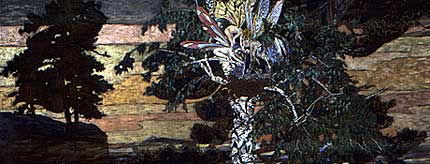

Fairy Dictionary

Teacher:
Alison Mays, George B. Armstrong School for International Studies
Suggested grade/s: 3
Illinois
Learning Standards
English Language Arts 1-3
Social Science 16
Fine Arts 25, 27
Estimated time: Three class periods
Mural/s addressed
Marion Mahony Griffin, Fairies and Woodland
Fairies, c. 1932, two-panel oil on canvas, George B. Armstrong
School for International Studies
Objective
Students create a dictionary of self-created
fairies and, in doing so, learn how to look up words in a standard
dictionary.
Key
terms
- mural
- dictionary
- pronunciation
- fairy
- heron
- birch tree
- woodland
|
Materials
- notebooks
- dictionaries
- colored pencils
- drawing paper
|
Procedures
- Have students write responses to the mural
in a journal. Ask directed questions: What do you see? What
is happening? What is about to happen?
- Ask students to write a list of words that
come to mind when viewing the mural. Have students share these
words with the class. Provide students with related vocabulary
words from the list of "Key terms" above.
- Homework: Have students look up the words
in a dictionary and write a.) the pronunciation; b.) part of
speech; and c.) complete definition of each word.
- Return to the mural. Discuss Marion Mahony
Griffin’s beliefs about the nature of fairies and their
function in everyday life. Ask students to discuss the image
using their new vocabulary.
- Read other tales, such as Peter Pan or
Cinderella, that include fairies as main characters. Ask students:
How do fairies help the main characters in the story? How
are they different from or similar to the fairies in Marion
Mahony Griffin’s mural? Develop a Venn diagram comparing
and contrasting the fairies in the chosen stories and those
illustrated by Griffin.
- Brainstorm with the students. Ask: What
other functions could fairies have in today’s world? How
could they help us in our daily chores?
- Have students create their own fairy. Ask:
What would the fairy look like? What is the fairy’s
name? What special skills does the fairy have?
- Have students create a dictionary definition
for their fairy. It should include a pronunciation guide, part
of speech, definition, and a brief paragraph summarizing one
of the fairy’s adventures. Have students refine and develop
their entries through peer editing and critique.
- Have students draw their fairy.
- Teacher: Create "Class Fairy Dictionary"
and distribute to students.
Evaluation
Base student achievement on written, oral,
and creative work for the project. Conduct a vocabulary test using
terms addressed in the project.
|


